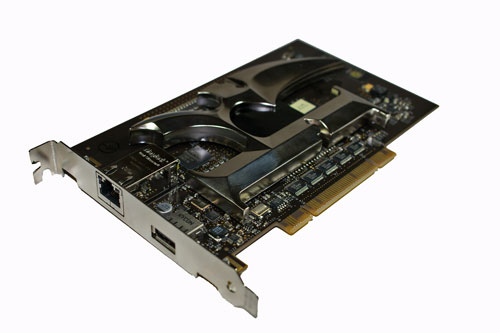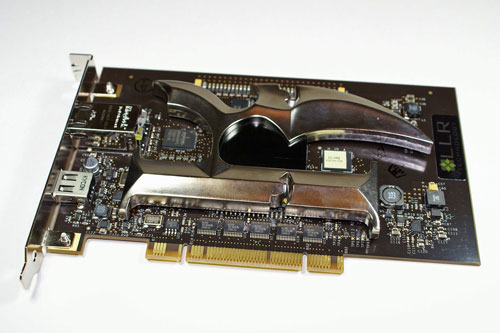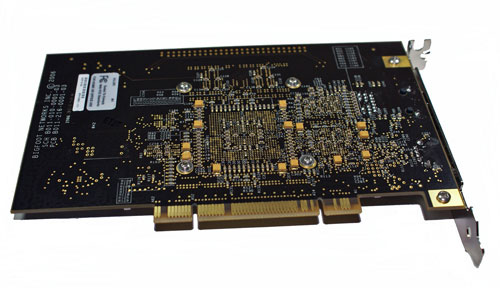BigFoot Networks Killer NIC: Killer Marketing or Killer Product?
by Gary Key on October 31, 2006 2:00 AM EST- Posted in
- Networking
Killer NIC Card
The Killer NIC ships with an installation disc that includes several Linux programs, a few decals, product documentation package, and a full retail copy of F.E.A.R. on DVD.
The Killer NIC is a very interesting card and since the Halloween season is upon us we have to say the thought of removing the "K" heatsink and using it as part of our Blade costume came to mind several different times. The PCB is black in color and contains a significant amount of components that you would never expect to see on a typical NIC. There are also several red LEDs on the PCB whose blinking movements can be adjusted by the control panel. Overall, the card's design theme follows its naming convention.
The card is equipped with a Freescale MPC8347E communications processor, a Xilinx Spartan FPGA, an integrated Broadcom Gigabit PHY, and 64MB of RAM for the embedded Linux build that is accessed by the FNapp Console. The Freescale MPC8347E communications processor is designed for general communications requirements from Ethernet routers to Internet network appliances. The Xilinx Spartan FPGA is a programmable gate array that houses Bigfoot Networks' proprietary and patent pending algorithms that also utilize the 64MB of onboard RAM.

The card utilizes a standard RJ-45 port and includes a USB 2.0 port. The USB 2.0 port is not visible to Windows and is designed to be used by an FNapp. The thought process is that an FNapp can read or write data to a flash drive or external HD. This would be very advantageous for writing data directly to an external hard drive via a BitTorrent type FNapp as one example.
The amount of integrated components along with its basic design features is one of the reasons why this card costs $279.99. This is a price tag that generally puts this card out of reach for most users who are typically satisfied with their NIC's current performance.
The card was very easy to set up. You need to disable your current NIC for optimum performance and compatibility. This is an action that we highly advise after a couple of aborted installs with the original driver set. The card requires a single PCI 2.2 slot and is only compatible with 32-bit Windows XP at this time. After installing the card, a quick reboot, and hardware recognition by XP, you install the driver set off the CD although we highly suggest downloading the latest release first. Another reboot is required and then you are set to use the card for total world domination. Well, at least this is probably your thought process if you read through the marketing material and other documentation online.
Additional 64-bit XP and Linux support is expected within the next six to eight weeks. However, it is still uncertain as to what features will be enabled for Linux and what if any performance benefits will be gained. Windows Vista support should be available by the time the OS ships and it will be interesting to see if there are any improvements considering Microsoft has completely rewritten the network stack code for efficiency and latency reduction. At this point in time there are no plans for a PCI Express version of the Killer NIC. According BigFoot Networks the PCI interface was utilized to improve transactional latencies, programming familiarity, and the fact that most systems have the required amount of PCI slots. We disagree with that last point as the majority of performance oriented boards are now PCI slot starved, and we would expect PCI-E to be a future consideration depending on the success of the current design.
The Killer NIC ships with an installation disc that includes several Linux programs, a few decals, product documentation package, and a full retail copy of F.E.A.R. on DVD.
 |
 |
| Click to enlarge |
The Killer NIC is a very interesting card and since the Halloween season is upon us we have to say the thought of removing the "K" heatsink and using it as part of our Blade costume came to mind several different times. The PCB is black in color and contains a significant amount of components that you would never expect to see on a typical NIC. There are also several red LEDs on the PCB whose blinking movements can be adjusted by the control panel. Overall, the card's design theme follows its naming convention.
The card is equipped with a Freescale MPC8347E communications processor, a Xilinx Spartan FPGA, an integrated Broadcom Gigabit PHY, and 64MB of RAM for the embedded Linux build that is accessed by the FNapp Console. The Freescale MPC8347E communications processor is designed for general communications requirements from Ethernet routers to Internet network appliances. The Xilinx Spartan FPGA is a programmable gate array that houses Bigfoot Networks' proprietary and patent pending algorithms that also utilize the 64MB of onboard RAM.

The card utilizes a standard RJ-45 port and includes a USB 2.0 port. The USB 2.0 port is not visible to Windows and is designed to be used by an FNapp. The thought process is that an FNapp can read or write data to a flash drive or external HD. This would be very advantageous for writing data directly to an external hard drive via a BitTorrent type FNapp as one example.
The amount of integrated components along with its basic design features is one of the reasons why this card costs $279.99. This is a price tag that generally puts this card out of reach for most users who are typically satisfied with their NIC's current performance.
The card was very easy to set up. You need to disable your current NIC for optimum performance and compatibility. This is an action that we highly advise after a couple of aborted installs with the original driver set. The card requires a single PCI 2.2 slot and is only compatible with 32-bit Windows XP at this time. After installing the card, a quick reboot, and hardware recognition by XP, you install the driver set off the CD although we highly suggest downloading the latest release first. Another reboot is required and then you are set to use the card for total world domination. Well, at least this is probably your thought process if you read through the marketing material and other documentation online.
Additional 64-bit XP and Linux support is expected within the next six to eight weeks. However, it is still uncertain as to what features will be enabled for Linux and what if any performance benefits will be gained. Windows Vista support should be available by the time the OS ships and it will be interesting to see if there are any improvements considering Microsoft has completely rewritten the network stack code for efficiency and latency reduction. At this point in time there are no plans for a PCI Express version of the Killer NIC. According BigFoot Networks the PCI interface was utilized to improve transactional latencies, programming familiarity, and the fact that most systems have the required amount of PCI slots. We disagree with that last point as the majority of performance oriented boards are now PCI slot starved, and we would expect PCI-E to be a future consideration depending on the success of the current design.










87 Comments
View All Comments
rqle - Tuesday, October 31, 2006 - link
I never like to bash a company product because always believed there a niche market, but at its very best, this product doesnt seem to justified the $300 price cost. I do believe many would buy it at a lower price.My current broadband is 3.0mbps/512kb, i can pay $5 more a month more for Verizon Fiop 15mbps/2mbp, i would rather go that route for my improve network + other capibilities. As for the side processing function, a cheap $200 (Athlon64 3200+ computer system) can do a whole lot more. Am not saying it a bad product, it just price way to high for me.
cornfedone - Tuesday, October 31, 2006 - link
SOS, DD.Just as we've seen with Asian mobos in the last few years, this NIC card is an over-hyped, under-performing POS. Just as mobos from Asus, DFI, Sapphire, Abit, and more have suffered from vcore, BIOS, memory, PCI slot and many other issues, the BigJoke NIC card is more defective goods with zero customer support. I'm sure everyone looks forward to a wiped hard drive image... due to a poorly designed NIC card.
Sooner or later consumers are gonna wise up and stop buying these defective products. Until they vote with their wallet instead of their penis, unscrupulous companies will continue to ship half baked POS products and fail to provide proper customer support. If consumers stop buying these defective goods, then the company will either correct their problems or go tits up.
autoboy - Tuesday, October 31, 2006 - link
I didn't buy a NIC to make up for my small penis, I bought a Porsche. Chicks don't notice my NIC.The K does look pretty cool. Maybe it will fit on my Porsche.
Frumious1 - Tuesday, October 31, 2006 - link
I dare say few if any people have purchased AGEIA or Killer NIC cards. As for your whining about ASUS, DFI, etc. I guess you're one of the people running a budget $50 mobo that can't understand what it's like to really push a system? Or are you the other extreme: you overclocked by 50% or more and are pissed that the system wasn't fully stable?slashbinslashbash - Tuesday, October 31, 2006 - link
You talk a lot about how it's virtually impossible to test something whose entire performance is based almost entirely on an Internet connection which is inherently variable. That's why you need some more control over the variables in your test. Namely, a LAN.For example... have 4 computers, each with exactly the same configs except for the network cards. One of them has the KillerNIC, the rest have different NICs. They are all running Unreal Tournament. You also have one computer set up as the server, on the same Gigabit Ethernet switch as the 4 "player" machines. The level is a small plain square room with no doors, trenches, or any other features. Each of the "players" is running the same script where they have unlimited ammo and a machine gun, running circles around and around, shooting constantly from the minute they respawn. Let the scripts run for 100 hours and capture the framerate and pings on each machine.
So you have 4 computer players running around in circles in a small square room, shooting each other for 100 hours. Yes, there will still be randomness, but over the course of 100 hours it should cancel out, and this test should be replicable. Any real differences between the NICs would come out over time. Run it again to make sure.
Or maybe that's not the best way of doing it. I don't even play UT2003 so I don't know what's really possible and what's not, but I've heard of people doing scripts and stuff. Maybe there are better ways of doing it, but you can eliminate the variable of the Internet connection by limiting your testing to a LAN.
Gary Key - Wednesday, November 1, 2006 - link
We tested over a LAN, the results were not that different, in fact the NVIDIA NIC and Intel PRO/1000 PT cards had better throughput and latencies the majority of the time. We did not show these results as the card is marketed to improve your Online Gaming experience. If the card had been marketed as a must have product to improve your gaming capability on a LAN then it would have been reviewed as such.
When we tested on the LAN the steps you outlined were basically followed from a script viewpoint in order to ensure the variables were kept to a minimum. We did not provide these results, maybe we should have in hindsight. Our final opinion of the card would not have changed.
Thanks for the comments. :)
Frumious1 - Tuesday, October 31, 2006 - link
The product is targeted at gamers. Look at the marketing material. now, while a LAN party goer might get some advantage out of it, there are FAR more people playing games from home using broadband connections. If this only improves performance in a LAN environment (clearly NOT what is being advertised), then it's already a failure. I like what Gary did here: look at real world testing and let us know how it turned out. Who gives a rip about controlled environments and theoretical performance increases if the reality is that the product basically doesn't help much? What's really funny is that they even show a ping "advantage" in FEAR of maximum 0.40ms and average 0.13ms. WTF!? Like anyone can notice a .13ms improvement in ping times! The frame rate improvements might be good (if they were available in many games)... still not $270+ good, though.Bladen - Tuesday, October 31, 2006 - link
Or as you touched on, do the test for a long time, or many many repeats, and let the averages soeak for themselves.shoRunner - Tuesday, October 31, 2006 - link
You pay almost $300 for the ultimate NIC card, and its PCI so it can't even get anywhere near gigbit throughput. AND the CPU utilization isn't even better than an onboard solution. PLEASE. If anyone is truely thinking about buying this, send me a PM I've got some beautiful ocean front property in Montanta to sell you for pennies on the dollar.mlau - Tuesday, October 31, 2006 - link
You underestimate this card greatly. This is the ultimate network card for linux:it could theoretically offload almost all of linux' network stack (including linux'
advanced filtering/routing capabilites and protocols). It's a firewall-router on a
card. IMHO the card is targeted for the wrong crowd (although I understand it somewhat,
since gamers are usually stupid enough to buy 2 video cards and other completely
unnecessary stuff [ageia comes to mind])